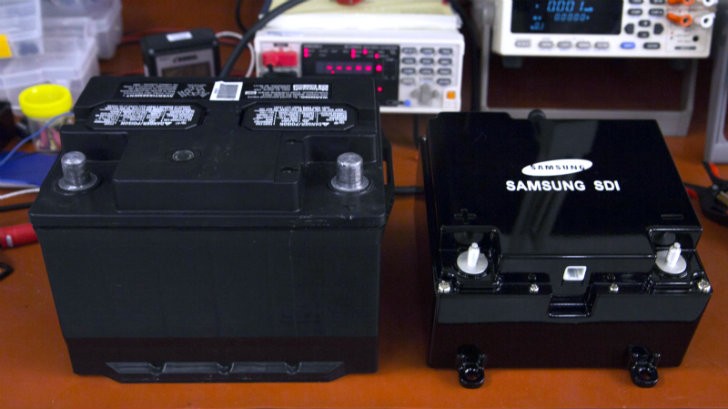When two of the most revered global brands join forces, it's certain something really good is gonna come out from that kind of union. After a 10-year-long research effort, Ford and Samsung revealed the first result of their technological partnership.
It comes in the form of a dual-battery system combining a lithium-ion battery with a 12V traditional car battery specially developed to enable regenerative braking technology in non-hybrid automobiles for improved fuel economy.
Emphasizing on leveraging innovation in consumer electronics batteries, the ultra-lightweight lithium-ion battery concept could one day render traditional lead-acid vehicle batteries obsolete.
Regenerative braking systems employed by current hybrid Ford-branded models are able to convert up to 95 percent of the kinetic energy lost during the braking process into electricity, which is sent to the battery to increase the pure-electric drive range of the vehicle.
The ensemble works in conjunction with the auto stop and start system, which seamlessly turns off the engine when the car comes to a standstill. Whilst the internal combustion engine isn't operating, an advanced battery powers vehicle accessories and systems until the driver begins to release the brake pedal, which restarts the engine.
Let's cut to the chase: sometime in the near future, the dual-battery system conceived by Ford and Samsung will theoretically reduce the power load supplied by an automobile's alternator, which ultimately reduces fuel consumption and greenhouse gas emissions. It's a win-win situation both for motorists and for Mother Nature.
“We are currently expanding our Auto Start-Stop technology across 70 percent of our lineup, and this dual-battery system has the potential to bring even more levels of hybridization to our vehicles for greater energy savings across the board,” declared Ted Miller, senior manager of Energy Storage Strategy and Research at Ford. “Although still in research, this type of battery could provide a near-term solution for greater reduction of carbon dioxide.”
However, Japanese automaker Mazda uses a similar regenerative braking system in non-hybrid models such as the 3 and 5. Named i-ELOOP, which is the short version of Intelligent Energy Loop, this system differentiates itself from the Ford-Samsung unit by using a capacitor instead of a lithium-ion battery.
Driven by tire rotation, a variable-voltage alternator generates electricity which charges the capacitor as the vehicle is coasting or decelerating. Further more, a step-down converter charges the traditional lead-acid battery of the vehicle. That zap is used to power various users such as the air-con, infotainment system and lights.
Emphasizing on leveraging innovation in consumer electronics batteries, the ultra-lightweight lithium-ion battery concept could one day render traditional lead-acid vehicle batteries obsolete.
Regenerative braking systems employed by current hybrid Ford-branded models are able to convert up to 95 percent of the kinetic energy lost during the braking process into electricity, which is sent to the battery to increase the pure-electric drive range of the vehicle.
The ensemble works in conjunction with the auto stop and start system, which seamlessly turns off the engine when the car comes to a standstill. Whilst the internal combustion engine isn't operating, an advanced battery powers vehicle accessories and systems until the driver begins to release the brake pedal, which restarts the engine.
Let's cut to the chase: sometime in the near future, the dual-battery system conceived by Ford and Samsung will theoretically reduce the power load supplied by an automobile's alternator, which ultimately reduces fuel consumption and greenhouse gas emissions. It's a win-win situation both for motorists and for Mother Nature.
“We are currently expanding our Auto Start-Stop technology across 70 percent of our lineup, and this dual-battery system has the potential to bring even more levels of hybridization to our vehicles for greater energy savings across the board,” declared Ted Miller, senior manager of Energy Storage Strategy and Research at Ford. “Although still in research, this type of battery could provide a near-term solution for greater reduction of carbon dioxide.”
However, Japanese automaker Mazda uses a similar regenerative braking system in non-hybrid models such as the 3 and 5. Named i-ELOOP, which is the short version of Intelligent Energy Loop, this system differentiates itself from the Ford-Samsung unit by using a capacitor instead of a lithium-ion battery.
Driven by tire rotation, a variable-voltage alternator generates electricity which charges the capacitor as the vehicle is coasting or decelerating. Further more, a step-down converter charges the traditional lead-acid battery of the vehicle. That zap is used to power various users such as the air-con, infotainment system and lights.


